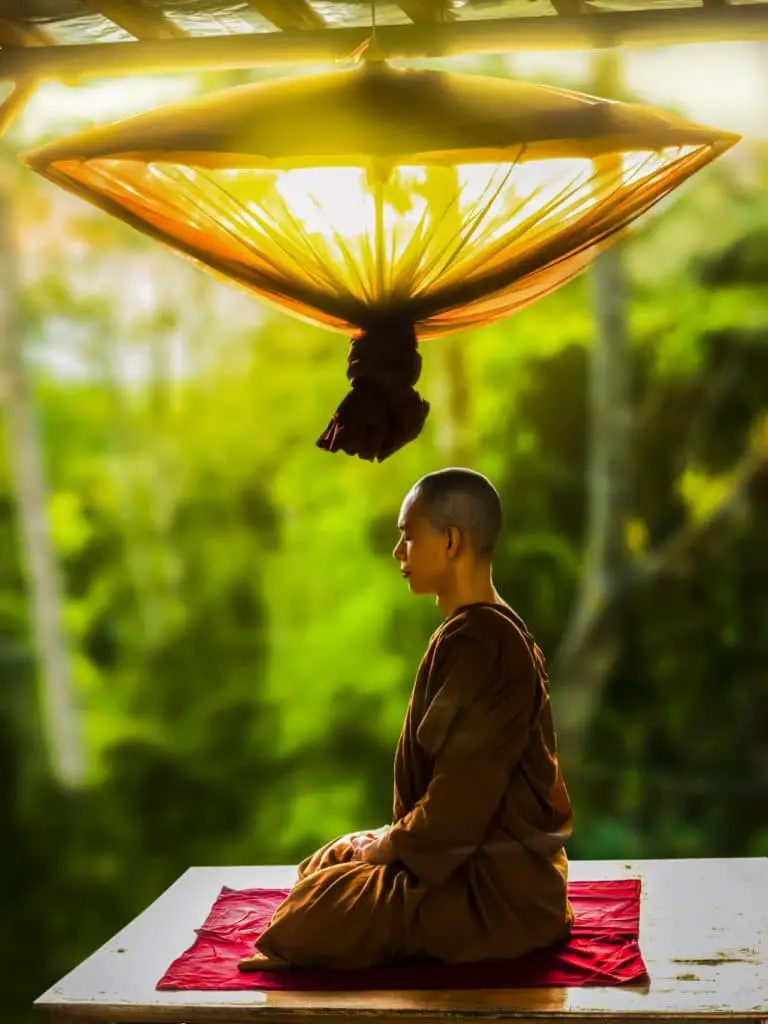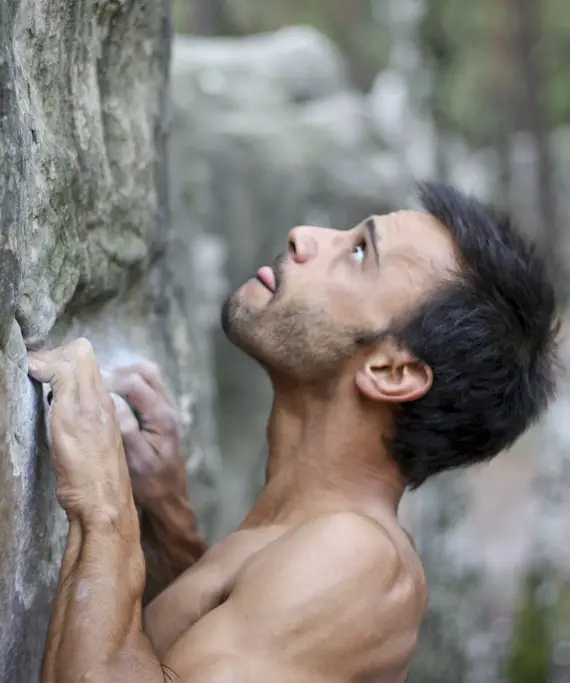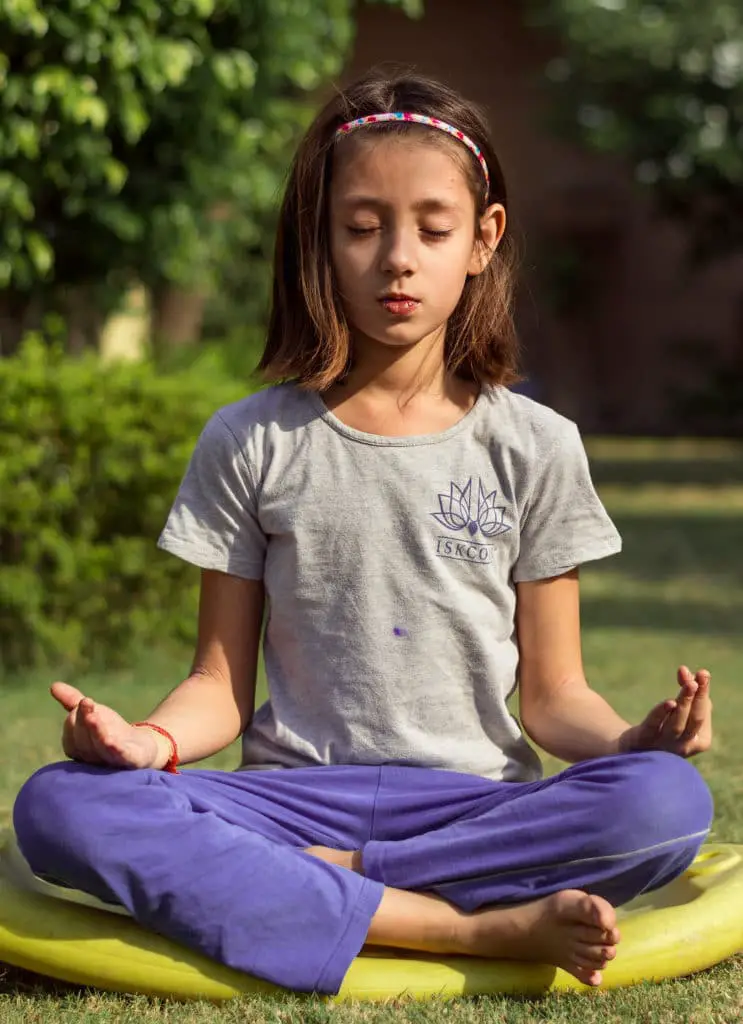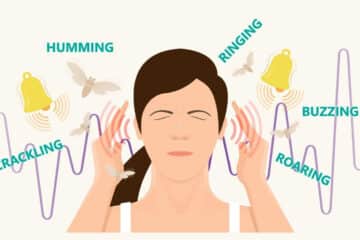The complete guide to mindfulness practices and exercises part 1
This post is the first in a series that details the full bandwidth of mindfulness meditation practices. In this first part, I cover the different kind of practices that exist and I will go in greater depth about what we call formal mindfulness practice.
In part 2, I cover the informal practices and also practices that are psychological hacks that use mindfulness. I call them mindfulness based coping exercises.
Enjoy!
[ez-toc]
What Kind of mindfulness practices exist
In the mindfulness tradition, there are a huge number of practices and exercises for you to try.
However, they all share the same aim. They are all geared at making you more aware of whatever is happening in the moment. This so that you will be able to respond to whatever is going on in the most skillful way possible.

Mindfulness practices are designed in such a way that you gradually learn to apply the technique in simple situations in order to be able to use them when confronted with a challenging situation.
It is not unlike sports or playing music where you actually do the same. Obviously, everybody doing sports or playing an instrument knows that there is a huge difference between the practice sessions and a concert or a competition.
But what is equally clear is that practice makes perfect. Both components (rehearsal/concert practice/competition) are skills that need to honed.
In the world of mindfulness, the analogue for the competition or concert is life itself.
So who is up for a challenge?
Different kind of mindfulness practices
Mindfulness practices are traditionally split into two broad categories: formal and informal. However, there is another important category that I cover in my next post, and that is mindfulness based coping exercises. They are usually
Formal mindfulness practices are those where you take of some period of your time to devote solely to mindfulness. These kind of practices are called mindfulness meditation.
Informal practices are typically done while you are performing other activities. You also set aside some time to practice but it is set in ‘daily life situations’. This mean people tend less to see them as just ‘doing nothing’.
Informal mindfulness practices are bridging the gap between the formal practices and a difficult situation that is occurring in your life and where you would like to respond in a more mindful way.
In the following paragraphs I will give an overview of the exercises that are available in our tradition. As you will see, there are a lot. So which one should I practice?
Excellent question!
Which exercise to practice when?
First you should make sure to have a regular practice. Doing one exercise every two weeks will not get you very far.
At the end of an 8-week mindfulness course the advice is given to practice ‘almost’ every day. Meaning that you should aim to do your exercises every day, but you should not beat yourself up if you skip a day. Or even two. But always get back in the saddle and restate your intention to practice almost every day and follow up on it.

Next, you also need to stick with a chosen practice for some time. Else you will never get better at the practice. Some exercises only reveal their depth after having been practiced for quite some time.
I recommend to stick to a certain routine for at least a week and see how it goes. And after a week, you can evaluate what you have learned and whether is is time to move on or stay with the practice.
Lastly, my advice is to have at least half an hour of formal mindfulness meditation per day and to add two or three informal practices. I found this to be a beautiful mix for myself. Especially in the beginning, but also in later stages.
Adding more might be too much to cope and you might develop a lot of resistance. And dragging yourself to your meditation cushion for a prolonged time is a surefire way to stop practicing altogether.
Formal practices.
Shamata or concentration meditation
The first thing your learn when you begin on the path of mindfulness, is that your mind is not very serviceable. It does not really want to do what you decided and he makes this clear by being distracted. By thinking about everything except what you want to focus on.
So the very first thing you need to learn is to concentrate on one single thing and not lose focus.
The traditional way this is accomplished is that the student will be given an object that he needs to focus his attention on. That can be anything from a candle to a painting. This object is used as an anchor. This means that each time our minds take us away with random thoughts about the past or the future, we gently come back to our given object and start over. We anchor ourselves in the present through our concentration on the object.
The object you use in your meditation can be anything, but in the modern mindfulness tradition, the breath is choses. Taking the breath has a number of advantages.

First of all, it is always available. Even it your chose to use it in conjunction with walking, it is still present. Second, it is always changing. Therefore you can see it as a metaphor for life. And since the instructions are to not meddle with the breath, it will also teach you acceptance. And lastly, the breath can be a safe haven. It is a neutral space where you can come back to when you are overwhelmed with your emotions. It is not the best one in the beginning of your training, but when you get to know it better, it is a great place to hang out when you need to take a break from disturbing thoughts or emotions.
Personal Experience: I saw this very clearly in my practice since I had this preconceived idea that a good meditation session was one with a calm breath. Now, although this is somewhat true, trying to make the breath calm is of no real value. The breath will settle on his own accord. And then you will have accomplished something real.
So now when my breath is erratic, I just watch it. And sometimes it calms down, and sometimes it doesn’t. And that is just the way it is.
Basic script of a concentration meditation session
- Sit down in a quiet space.
- Notice yourself sitting down. Notice touching the floor or the chair you are sitting on.
- Next, start noticing the breath. Notice the inhalation. Notice the exhalation.
- When your mind wanders, gently bring your mind back to the breath and continue observing the breath.
- If you have the tendency to beat yourself up, because your mind wandered, gently let this tendency go and simply come back to the breath.
- Do this exercise for 5 to 30 minutes.
- Once you finished your meditation session, take a few moments to come out of the meditation. Slowly open your eyes and notice the world around you. Now slowly get up and continue with the rest of your day while being mindful.
If you want, you can also follow along with the following guided meditation.
Body scan meditation
In the body scan meditation, focus is brought to all the parts of the body. In the modern mindfulness tradition, the aim of this meditation is to be able to move one’s awareness to the different part without judgment. We just notice whatever is present.
This is in contrast with what is being done in yoga. In that tradition, the main focus of the body scan is to fully relax the body in order to not get into the way when the yogi is going for meditation.

So in the yoga tradition it is seem as a preparation for meditation, whereas in the modern mindfulness tradition, it is an important meditation on its own.
Why is the body scan such an important meditation?
The body scan is specifically designed to be able to see our bodies in a different way. Without judging. An important skill in mindfulness is to learn to observe whatever happens without judging and we begin this task with the body.
And this exactly what the body scan is designed to do. We are instructed to focus on all the different body parts and notice whatever there is to notice.
That means there is no right or wrong observation. So if you feel warm or cold, or tense or relaxed, all of this is fine. You are honing your skill of observation and not judging. But even people who have trouble sensing their body parts are encouraged to come to terms with this. This also is some important skill that can be learned through this practice: acceptance.
For a more in depth discussion of the body scan, see my dedicated post on the subject.
Basic script of a body scan meditation
- This exercise can be done sitting or lying down, but traditionally, it is done lying down.
- To start the exercise, lay down on your back on a yoga mat or in your bed. Do not make yourself too comfortable since you want to avoid falling asleep. This is something that happens a lot when performing a body scan meditation. But also here, do not be hard on yourself when this happens. It is normal. Just notice it and continue with the practice once you have woken up again.
- If you have back problems, you can raise your legs and put your feet closer to your bum. In this way there is less tension on the backbone.
- Now, start by noticing that you are lying down. Notice also the contact you make with the ground. Is this firm, soft, warm, cold, or even something completely different.
- Next, bring your attention to the toes of your left foot and notice what there is to feel. Notice warmth or cold. Or notice tension in the toes. Maybe you will come to the conclusion that you can be aware of only three of your five toes. It will be different for everybody.
- But whatever you notice, be at ease with it. Do not overlay it with judgements. And if you notice yourself judging yourself, do not beat you up on that either. It is perfectly normal. We all do this. The practice is just noticing it and not doing anything more.
- No slowly move up through your body and bring your awareness to all your body parts in the same way you did for your toes. Take it really slowly. And look into detail to each and every body part you encounter.
- When you have reached the top of your head, take a few moments to feel your whole body. Has this feeling changed since you began the exercise? It the body more relaxed, or more tense? Or maybe some parts are sore from lying down. Just be aware of whatever is happening.
Here you can follow along with a guided body scan led by John Kabat Zinn.
Mindfulness meditation or vipassana.
Full fledged mindfulness meditation takes the 2 previous exercises a bit further. These exercises build your concentration muscle in order to not get distracted too fast and they teach you to do this in a non-judgemental way.
But they leave out an important part of our experience as human beings: thoughts and emotions.
Why?
The reason behind this is that they take us away much more easy. Once you start watching your thoughts and emotions, you will see that the skill you built up with the concentration meditation will come under pressure.
You will, again, be distracted more easily.
But that is not a problem. It is also part of the mindfulness journey.
So what is so different about this exercise?
Well, in the concentration meditation on the breath, once we noticed that we were distracted, we acknowledged this fact and then gently came back to the sensation of breathing.

In mindfulness meditation, we will not do this anymore. Once we notice thinking, we will continue noticing out thoughts, without interfering with them.
As you can imagine, this is not an easy feat. We are so habituated to thinking, that it is hard for us to not identify with our thoughts. And yet, this is exactly what needs to be done. We need to develop the ability to watch our thoughts and emotions as if they were alien to us. As if they were happening to someone else.
With practice you will see that seeing your thoughts as alien to yourself is incredibly empowering. It means that you do not have to listen to the self destructive talk in your head. You can just watch these thoughts and say: ‘it is not me. It is just happening to me’.
Another thing this exercise brings you is the insight that your thoughts are just that, thoughts. They are not necessarily truths. Especially the self-defeating one’s. You will now have the option to either accept your thoughts or to leave them as they are.
So, you chose the thoughts that are nurturing you and you let be the ones that try to put you down.
Emotions are treated in the same fashion as thoughts in mindfulness meditation. Just watch them as if they were happening to someone else.
Another interesting thing you might notice is the relationship between your thoughts, emotions and bodily sensations. You will start to see that they are all interrelated. One is followed by the other, or they happen together.
The nice thing about this is that you will be able to predict your future behavior based on early signals you get.
Personal experience: In my case, it was with my kids making a lot of noise in the car that I discovered the power of using mindfulness and early warning signals. I always got very angry at them, even shouting at them. Until I noticed in my mindfulness practice that I always started to get tense and that the noise of the radio was also contributing to the fact that I could not contain my anger. So the next time my kids started to quarrel, I noticed myself getting tense (my early signal), decided to turn down the radio and to ask them, calm but firm, to stop making so much noise. And the wonder happened: they still made noise ;-), but far less. And I could handle this level of noise because the radio was not interfering.
Basic script of a full mindfulness meditation.
- Sit down in quiet space. Unplug the phone and make sure you will not be disturbed for whatever time you decided to meditate.
- Start by noticing yourself sitting down. Gently scan you body for tension and if possible, let go of this tension. Do not stress over this. If the tension stays, just remain with the tension. Do not try to forcibly make it go away.
- Now, start noticing your breath. Notice the in breath, notice the out breath.
- When a thought or an emotion or some bodily sensation takes you away from the breath in some way, shift your attention to this part of your experience. Meaning that you make the emotion or thought your meditation object.
- Observe all the details there are to be perceived from you newly chosen object. You can for instance see if the emotion get more intense when you look at it. Or less. And maybe if first get more intense and then less.
- Just observe whatever is happening.
- In the beginning thoughts will easily take you out of concentration. And you will get lost in you thoughts. Therefore an easy practice is to note that you have a thought.
- Let say a thought about your work comes up and your say to yourself: ‘Ah, a thought’. But do not try to reason with it or to make it go away. Let the thoughts and emotions run their course.
- Once the thought or emotion have stopped asking for your attention, gently come back to the breath. This will be you anchor as you might have lost a lot of concentration power in watching the thoughts or emotions. Just come back to the breath and stay there for some time, until something new arrives.
- Continue in the same way for 5 to 30 minutes and then gently open your eyes and look around. Decide you will continue doing your daily activities with more mindfulness, that has been grown with the practice you just did.
In the video hereunder, you can follow along with a short guided mindfulness practice
Raisin meditation
As said in my other blog post about the raisin meditation, this exercise is not about raisins. It is about getting to know reality in a richer way than we usually do.
Usually, we run through our lives on automatic pilot. Who hasn’t got the experience of going for groceries to find out that you are on your way to work because the first part of the road is the same. You just ran on auto pilot.

Running on autopilot makes you see life in a more limited, narrow way. And the raisin meditation is designed to make us aware of just that fact. The meditation is designed to make us experience life more fully. It makes us more open to the complete experience of whatever is arising in the present moment.
And it does this via the exploration of a small edible object. In this case a raisin, but truthfully, it could be anything.
We try to experience the raisin with all our senses and in doing so, we remark there is much more richness to the simple raisin than we first did.
While doing this, we might enjoy our experience of eating the raisin more, which is an added bonus.
It is a simple yet elegant meditation.
Basic script for the raisin meditation.
- Take a raisin in you hand and close your eyes.
- Feel the weight of the raisin in your hand. Can you feel it lying in your hand?
- Next, take the raisin between your thumb and index finger and gently squeeze it. What does this feel like? Soft? With a hard core inside? Or something else.
- While squeezing, bring the raisin to your ears. Can you hear it squeaking? Does it even make a noise?
- Then, smell the raisin. Some people with a good sense of smell tell me it has a typical raisin smell. Can you distinguish that? Or do you smell something else. Maybe there are smell from other fruits mixed in it.
- Lastly, put the raisin in your mouth and play with it. Roll it over with your tongue. Is the taste sweet? Are there other flavors present? Now bite in the raisin and feel the full flavor in your mouth. Next you can swallow the raisin.
- Before you end the practice, reflect a few moments on the exercise you just did. Is this the usual way we experience daily life? And is this fullness something you would like to experience more? You can. FOr instance by repeating the same exercise with a piece of chocolate ;-).
If you want, you can also follow along with my own guided raisin meditation.
Metta or loving kindness meditation.
Metta or loving kindness meditation is a kind of meditation that we in the west, with our emphasis on the brain, sometimes have trouble doing. Especially in public. We fear of being ridiculed for having our heads in the clouds. Not down to earth enough.
But this practice is a life saver. There is scientific evidence that of all the components of mindfulness meditation, this is the one having the largest overall effect. The effects range from increased well being to faster healing, over decrease in migraines to shutting down your internal critic. And there are more.

But, as with many of the best things in life, metta is an acquired taste. You have to practice it for some time to know its beauty and power.
Loving kindness meditation is a flavor of concentration meditation. It uses a sentence as an object to concentrate upon. The sentence is a as simple as: “May I be happy”. As you can see, the sentence represents an aspiration to be well.
This simple aspiration has the power to completely open our hearts. Open it to include ourselves in our own love. A very beautiful goal.
In times where people are beating themselves up more and more, it is not surprising that this simple meditation can have a dramatic impact.
But it goes further. The practice continues and also encompasses the people we love and also those to whom we sometimes are mean. The aspiration, “May you be happy”, when remembered in the midst of an argument, can make us open to our loved ones and end the argument in a way that is good for both parties.
If we wish, we can also include persons that we have no real connection with. A stranger we saw on the bus and looked tired. May he be happy as well.
Finally, and most difficult, is to also include a person we dislike. If we can find it in our hearts to wish this person well also, we can let go of all the resentment in our body. Something that usually brings a warm and wonderful feeling.
I urge you to try this meditation, especially if you think it is not for you. Nothing in my practice has brought me greater joy than metta meditation.
Basic script for metta meditation
- Sit down in a comfortable chair.
- Close your eyes and think about a person that means a lot to you. A friend, a lover.
- Repeat to yourself while thinking of this person: “May you be happy. May You be well. May you be free of suffering”. And bring forth the aspiration that this comes true. Do this for a couple of minutes.
- Now bring yourself to the forefront of your mind. And say to yourself: “May you be happy. May You be well. May you be free of suffering”. If you do not manage to believe the words, do not worry. Just continue and say the words. Do this for a few minutes.
- If you want you can now repeat with a person that you barely know and then with someone that you find difficult to be with. Also here, just repeat the words and do not try to force any outcome upon yourself.
- After a couple of minutes, open your eyes check with yourself if anything has changed in your outlook of the world. It might be different, it might not be.
You can follow a guided mindfulness practice here.
Mindfulness practices that are both formal and informal.
The following mindfulness exercises can be practiced easily in both a formal and informal way.
I agree that this is more or less the case for all exercises, but for walking and eating meditation I have found that I practice both forms equally often. And with equal enjoyment. Something that is far less true for all he other exercises.
Walking meditation
In walking meditation, the focus is moved from the breath towards the movement of the legs and feet.
This movement, much like breathing, is both rhythmic and never the same. It is therefore simple to follow and concentrate on as it is always changing and new.
Remark though that our minds will have the tendency to find this rather boring after some time. It is only through perseverance that the beauty of the breath and simple movement can be fathomed.

In the beginning stages, walking meditation is also a form of concentration meditation. Therefore the movement of the feet and legs is followed in great detail. When the mind inevitably wanders, we just bring it it back to the object of meditation.
In a later stage, one can combine walking meditation with mindfulness meditation. To do so, each time your mind wanders you do not bring it back to the movement of your legs, but instead you halt. You stop walking. And you give full attention to your whatever was distracting you. Once the distraction has lessened his hold on you, you can resume your walking.
But my favorite way of doing walking meditation is actually in nature. Of course, I do not focus solely on my feet when walking in nature. That would be a real waste. No, I keep a peripheral awareness of my my legs moving and the rest of my attention goes to my surroundings.
The feeling I get when doing this is indescribable. It is a kind of warmth and well being that feels like being nurtured. Well, words fail me at the moment, but I hope I conveyed the idea.
Basic script for an informal walking meditation
- When you want to try walking meditation in nature, or anywhere else in an informal way, it is best to do you walk alone. Doing it with somebody will likely just distract you.
- Start of by reminding you that you are going to perform a practice. It is not just a stroll in the park.
- Before starting, just stand still for a couple of moments and if possible, close your eyes for a few moments. If this is not possible, just do the rest of the exercise with your eyes open. Start by feeling your body stand still. Then, notice your breath going in and out. Continue being aware of your breathing for a few moments and then open your eyes.Before starting, just stand still for a couple of moments and if possible, close your eyes for a few moments. If this is not possible, just do the rest of the exercise with your eyes open. Start by feeling your body stand still. Then, notice your breath going in and out. Continue being aware of your breathing for a few moments and then open your eyes.
- Take a good look at your surrounding while also being aware that you are standing still.
- Now, without loosing focus of your surroundings, focus on your left leg and put it a step forward. Now repeat with your right leg.
- Continue walking but do not walk fast. It is important that you are both aware of your feet moving and of your environment.
- When you get distracted in rumination or thoughts of past and future, stop. Pause for a moment and have a look at your thoughts or emotions. But do this without judging your thoughts or yourself. Just be aware of what was going on in your mind.
- Continue your walk and enjoy 🙂
You can follow along with this guided meditation.
Eating meditation
For me, eating meditation is the most difficult one. To be honest, I am seldomly mindful when eating (yes, even long time meditators have a lot of areas they can improve in 🙂 ).
The main reason I have such difficulty in eating meditation, I think, is because I always eat together with people. And of course we talk. Talking and being mindful is another difficult task. So combining eating with talking is at the moment almsot impossible for me.
Therefore I recommend that you try eating on your own, just like the walking meditation. If you want to have success in eating meditation, it needs to be tackled through deliberate practice. Now that I think of it, all of mindfulness if actually deliberate practice. But that will be for another post.
But mindful eating has a lot of benefits. For one, it makes you slow down in your eating. And this means you will both enjoy your food more AND eat less of it. Which is a huge bonus.
Basic script for eating meditation.
- Start by closing your eyes for a few minutes and to feel you body sitting in your chair.
- Notice yourself breathing. Do this for a few minutes and then open your eyes.
- Look at your food and see the colors and shapes that are in your plate.
- Also notice the smells that are coming to you. Can you distinguish the different smells. Do not make this into a competition. If you can great, if you cannot, even better.
- Now take a bite from your food and chew it real slow. Savor all the tastes that fill your mouth. Try to keep your attention to the taste and do not let your mind wander.
- When it does wander, gently bring it back to the food. You will see that you will lose your intrest in the food as the meal progresses. Notice that also and try to bring your attention back to you food each time it happens.
- If you want, you can also combine mindful eating with a gratitude practice. You can be grateful that you can eat all this wonderful food. You can be grateful for the people that have cultivated the food. And you can be grateful for the person that cooked your meal. Especially if you did it yourself.
You can also follow along with the following guided mindful eating meditation.
Conclusion
I hope I have given you and overview of the different kinds of practices in the modern mindfulness tradition. They are very diverse but mainly serve two distinct purposes: growing your concentration skill and growing your mindfulness skill.
In the next part of this series I will cover the informal practices and a number of practices from modern psychology that have been infused with mindfulness in order to learn coping strategies.
Hi, I’m Olivier Devroede and I have been meditating seriously since 2009.
Due to the great benefits I have seen in meditating, I decided to become an MBSR trainer myself and start a blog.


